
Review of “Adobe Animate Essentials” on Skillshare: 2D Animation Fundamentals
Can the Adobe Animate Essentials course get you started in 2D animation? Here’s a review of the course and my experience taking it.
While traditional methods have their advantages, Visual Note-Taking is a rising star in the world of note-taking. It completely changes the game by fusing the power of words and images to make your notes not only informative but also interesting and memorable.
E-student.org is supported by our community of learners. When you visit links on our site, we may earn an affiliate commission.
The need for effective notes has progressed far beyond bullet points and scribbles to accommodate the current flood of information and constant distractions of the digital age. Enter visual note-taking, a creative strategy that alters the way we absorb information and communicate it.
Visual note-taking differs greatly from traditional note-taking methods, which rely primarily on text and linear structures. It uses a combination of words and images to create a dynamic mix of artistic expression and cognitive analysis. This strategy successfully transforms complex information into visual narratives that engage the senses and embed ideas in memory.
Linear text, bullet points, and structured outlines are common components of traditional note-taking techniques. While these methods have their merits, taking visual notes gives the process a creative and spatial component. Visual note-takers use illustrations, symbols, colors, and typography in addition to words to convey ideas.
This multisensory approach promotes a deeper understanding and better retention of important information because it is easier to see connections between ideas in a visual context. It is also due to the fact that while words are abstract and challenging for the brain to retain, images are concrete and much easier to remember. Taking notes in this creative manner can also help build stronger connections among learners, resulting in greater engagement, stimulating the exchange of ideas, and increasing knowledge sharing.
In this article, we will look into visual note-taking, exploring how it differs from traditional note-taking methods and how you can kickstart your visual note-taking journey. We will also draw inspiration from the achievements of skilled visual note-takers who have mastered this art as a means of communication and self-expression. In addition, we will provide you with useful learning materials to help you get started with your own visual note-taking exploration.
Visual Note-Taking, which is also referred to as sketch noting or graphic recording, involves the use of drawings, symbols, colors, and typography in addition to traditional note-taking methods. This approach allows for the visual synthesis and representation of intricate information. Instead of depending solely on text, visual note-takers integrate images and design elements to craft a more captivating and informative representation of the topic at hand.
As research suggests, visual content facilitates the connection of information, leading to a higher quality of generated ideas. Visual note-taking simplifies complex concepts, making them easier to understand and remember. It promotes active listening because note-takers immerse themselves in the content, enabling them to capture and recall crucial information more effectively.
Visual note-taking is a flexible tool that can be applied effectively in a variety of situations. It shines in scenarios like business meetings, conferences, classroom discussions, and any group conversations involving brainstorming or complex information sharing. If you’re dealing with intricate content or aiming to encourage active idea sharing among your audience, visual note-taking can be a valuable aid in enhancing comprehension and participation.
Furthermore, like other visual note-takers, you can also incorporate this technique into your personal journals as a means of self-expression, documenting life goals, and conveying emotions.
Getting started with visual note-taking is both simple and rewarding. Here’s a step-by-step guide:
To help you get started with taking visual notes, let’s have a look at some inspiring work by skilled visual note-takers who have honed their craft over time. These individuals have mastered the art of transforming complex data into visually appealing and easily understandable representations.
Mike Rohde is a prominent personality within the field of visual note-taking, recognized for his pioneering and impactful contributions to this creative discipline. He is celebrated for his innovation and influence, which extend through various mediums, including books, workshops, and online content. His body of work showcases how it can effectively simplify intricate information and facilitate creative self-expression.

Sunni Brown has made her mark by writing books, hosting workshops, and delivering captivating speeches that underscore the significance of integrating visuals into our cognitive processes.

Robert Dimeo is an expert in engineering and physics and also a visual note-taker who aims to unite the worlds of art and science, turning complex scientific ideas into understandable visuals.
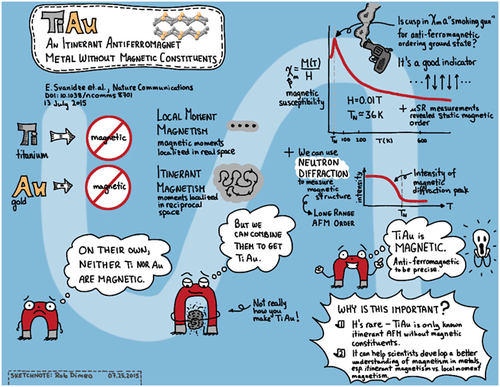
Veronica Erb is a gifted note-taker who excels at turning lectures, workshops, and other events into vivid and eye-catching visual narratives. Her work is a good example of how to bring a lively and engaging element to these gatherings, encapsulating the key ideas of speeches and discussions in clear, concise text and vivid illustrations.
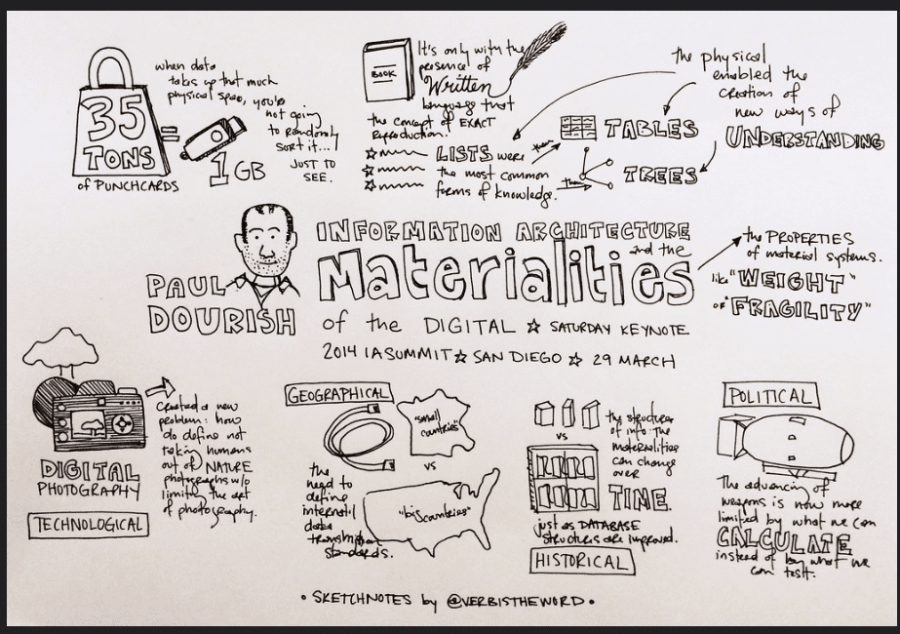
The last entry on our list isn’t an individual but rather a renowned agency, Ink Factory, specializing in the realm of visual note-taking. They focus on visual note-taking services for a diverse range of events, meetings, and conferences, producing visually compelling and informative records that enhance people’s grasp of key concepts.
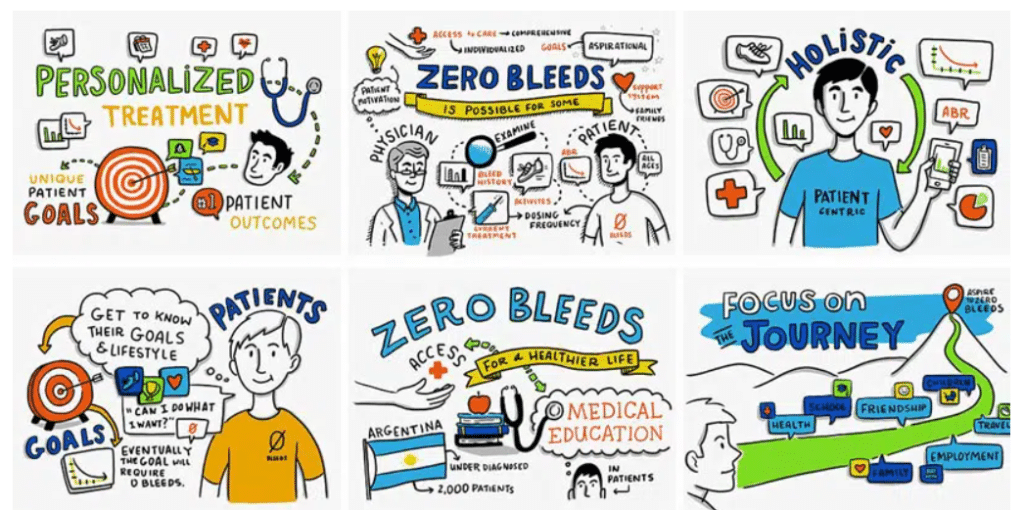
Ready to dive in? Here are some valuable learning materials worth exploring:
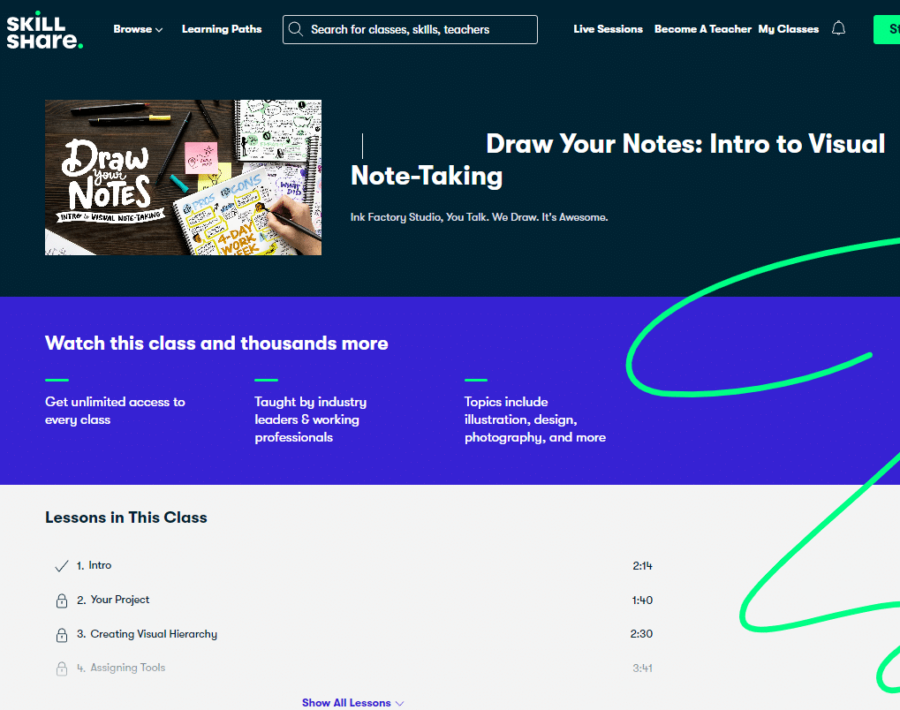
For anyone interested in the practice of visual note-taking, the Ink Factory course “Draw Your Notes: Intro to Visual Note-Taking” on Skillshare is a great place to start. Ink Factory, a company renowned for its proficiency in developing captivating visual content, contributes its knowledge and abilities to this course to assist students in recognizing the value of visuals in absorbing and remembering information.
The fundamentals of taking visual notes, such as sketching methods, iconography, and note-structuring techniques are be covered in this course. Ink Factory’s practical insights enable students to take complex ideas and turn them into clear and memorable visuals.
This course stands out for its hands-on methodology, which enables learners to develop their visual note-taking abilities over time. “Draw Your Notes” provides helpful tools and techniques for enhancing your note-taking skills and embracing the world of visual communication, whether you are a student, professional, or just someone who enjoys taking imaginative notes.

The Skillshare course “Graphic Recording 101: Learn to Draw Live Visual Notes” by Leah Lavelle is a wonderful resource for anyone interested in learning more about the fascinating field of graphic recording. In this course, professional graphic recorder Leah Lavelle provides insightful analysis and helpful advice.
Students can anticipate learning critical abilities throughout the course that will enable them to take visual notes during live discussions and events. The course material teaches participants how to draw live while telling stories in real time and how to do so in an interesting and educational way.
Anyone looking to improve their visual communication abilities will find this course to be a useful resource thanks to Leah Lavelle’s expertise in graphic recording. “Graphic Recording 101” offers a rewarding learning experience that you can complete in less than an hour, whether your goal is to expand your professional toolkit with visual recording or you simply want to experiment with a creative method of taking notes.
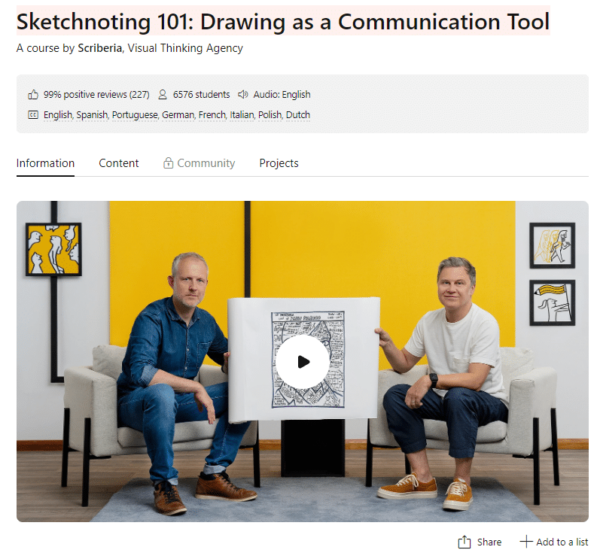
Led by the experts at Scriberia, this course provides insights into the art of fusing words and illustrations to effectively convey ideas. “Sketchnoting 101: Drawing as a Communication Tool” on Domestika is an exciting opportunity to explore the world of sketchnoting. It is a fantastic choice for anyone looking to improve their communication skills using visual elements.
Through the course, participants can expect to learn practical sketchnoting skills, such as how to make interesting visual notes, use various drawing tools, and establish their own personal style. They can also explore real-world applications of sketchnoting, ranging from business presentations to personal journaling.
You can count on this course to be credible and knowledgeable because of Scriberia’s standing as a visual communication agency. ‘Sketchnoting 101’ on Domestika promises to be a useful learning experience in the field of visual communication, whether you are a beginner or looking to hone your sketchnoting abilities.
In conclusion, while taking visual notes can be a bit time-consuming and challenging (depending on how artistically inclined you are!), it is a flexible and effective note-taking method that can improve understanding, communication, and creativity in a variety of contexts. Whether you’re a student, a professional, or simply someone who enjoys creative expression, visual note-taking can be a transformative addition to your skill set. You can set out on a quest to unleash your own creativity in this distinctive art form by looking at the work of accomplished visual note-takers and utilizing learning resources taught by experts. Give it a try and discover the power of using words and pictures together to effectively capture and communicate your ideas. Happy sketching!


Can the Adobe Animate Essentials course get you started in 2D animation? Here’s a review of the course and my experience taking it.

This is an honest review of Vishen Lakhiani’s The 6 Phase Meditation by a chronic multitasker for whom meditation is… difficult. Follow along on my journey through this meditation course offered on Mindvalley.

These are efficient note-taking methods that anyone can pick up and use to take better notes.